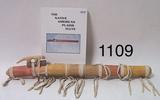Creative Commons CopyrightsI am exploring the use of "
Creative Commons Copyrights" for my material posted here. I hate having to add the "copyright by...." after the playing tips and stuff, but since I am pulling it out of my Beginners Guide to the Native American flute, I have to do this in order to protect the document. But I'd also like folks to be able to borrow what they need, because for the most part I have borrowed the knowledge that was lent me by those who came before.
In researching the Creative Commons Copyright idea, I have learned that this is an interesting new way to provide access and use of your material, while protecting some of your rights as a copyright owner.
First of all, copyrights are protected as soon as you finish your material, whether or not you include the famous (C) symbol. This includes any song which you record, or lyrics, poem, or story which you write. You own the exclusive rights to copy, distribute and sell this material.
Let's say that you create and record a new song with your flute. If you burn this to a CD or post it online on a bulletin board, you own the copyrights to the song. That means that someone is not entitled to take your recording and use it as a soundtrack for their class project or vacation slideshow. But what if you'd like to give folks the rights to use your awesome new song as long as they don't make money from their new creation? Well, they can certainly contact you for a release of the copyright, but unfortunately this requires a bit of knowledge and probably some lawyer-speak to do it right. This is where the Creative Commons was born. The Creative Commons defines a new spectrum of copyright possibilities where you can "preapprove" some uses of your material, while restricting others. Creative Commons provides standard "Copyright" definitions which include common language that anyone can read, the lawyer speak that will hold up in a court, and computer readable language that will (in the future) support computer searches for material with specific Creative Common licenses. This means that when you publish (or upload) a song with a Creative Commons license, you can tell the world that (for example) commercial uses of your material are restricted, but any non-commercial use is OK as long as you are given credit for the material. A
FAQ is posted on the Creative Commons website.
I will post more on this topic in the coming weeks as I learn more about the issues involved.




 If you were planning to bid on any of Doc Payne's flutes or just wanna check out the action, don't forget!
If you were planning to bid on any of Doc Payne's flutes or just wanna check out the action, don't forget!